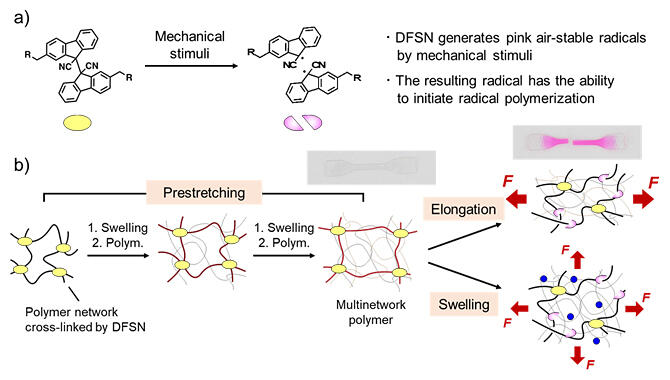Professor Hideyuki Otsuka and Doctoral Student Takuma Watanabe of the Department of Chemical Science and Engineering, School of Materials and Chemical Technology at Tokyo Institute of Technology, have succeeded in developing a polymeric material that exhibits highly sensitive color change due to bond breaking when a force is transmitted to the molecular chain by a shape change. They focused on the deformation of polymer chains during the swelling process in which cross‐linked polymers, where molecular chains are linked in a three‐dimensional network, absorb liquid and swell. They identified the visualization of the force generated in the chain and its scission reaction mechanism.
The research group focused on the difluorenylsuccinonitrile (DFSN) framework, which produces a less reactive and stable radical when subjected to force. DFSN is chemically stable at room temperature, but when force is applied, the central carbon‐carbon covalent bond selectively splits, resulting in a pink radical. DFSNs can therefore detect the force exerted on polymer chains by color change, but until now, breaking the covalent bonds of DFSNs has required large forces and the reaction efficiency has been low.

Provided by Tokyo Institute of Technology
In response to the challenge, the research group devised a method to introduce DFSN into multi‐network polymers where a pre‐stretched mesh is constructed. Multi‐network polymers are characterized by their taut network structure, which can be exploited to reduce the tensile strain required to activate DFSN and improve reaction efficiency.
In the study, cross‐linked polymers with DFSN introduced within the structure of multi‐network polymers with pre‐stretched meshes were synthesized and immersed in various solvents. The results showed a marked color change in solvents with excellent affinity for polymers and large swelling (increase in volume due to absorption of solvent by the cross‐linked polymers). Quantitative evaluation of changes in the amount of radicals during the swelling process using electron spin resonance (ESR), which can detect and quantify radicals, showed that radicals derived from the dissociation of the DFSN skeleton increased with the progress of swelling.
In the gel state, where the polymer chains are actively moving, the amount of radicals immediately decreases due to recombination reactions between radicals, but in the taut state of the polymer chains, the recombination reactions are specifically suppressed and a color change is observed. The substantial reaction mechanism coincides with uniaxial elongation and swelling deformation, and the chemical reaction is driven by the tension generated when the mesh containing DFSN is stretched to a large extent. Furthermore, the researchers used the fact that DFSN‐derived radical species produced by solvent swelling can act as initiators of radical polymerization to achieve acquired modification of cross‐linked polymers.
According to Otsuka, "The results of this study may contribute to a better understanding of the degradation and fracture mechanisms of polymeric materials, as the cleavage of cross‐linked polymers can be detected quantitatively and visualized. On the other hand, it could also provide important clues for the development of next‐generation polymeric materials with low environmental impact, whose degradability is greatly enhanced when swollen with water or seawater."
■ Multi‐network polymers: A method of achieving a network structure stretched from its initial state by forming a new network inside the cross‐linked polymer.
Journal Information
Publication: Angewandte Chemie International Edition
Title: Swelling‐induced Mechanochromism in Multinetwork Polymers
DOI: 10.1002/anie.202216469
This article has been translated by JST with permission from The Science News Ltd. (https://sci-news.co.jp/). Unauthorized reproduction of the article and photographs is prohibited.




